
Contrary to what you might assume about social media marketing, you don’t have to be an influencer to capitalize on the social media platforms where your customers spend time. With the right strategy, your brand and products can grow consistently, bringing more prospective customers to your site. But to do this, you will need to understand the rules of ecommerce social media and sometimes, and sometimes, be willing to break them.
In this article, you will learn about social media for ecommerce sites. You will learn the latest statistics and best practices that apply to all platforms and then case studies of ecommerce brands leveraging a specific platform to catapult their revenues.
Let’s get started.
Surprising Facts About Social Media
Let’s start with perhaps the most surprising fact. Facebook is still the most frequently used social media platform. Even considering this statistic, most people think TikTok and Instagram are the best social media platforms. However, “best” isn’t based on eyeballs but on how Facebook takes a “pay to play” approach with business accounts.
TikTok is currently leading the way with ecommerce conversions, but the price point is essential. To capitalize on the power of impulse purchases, you need to sell a product for approximately $25-35 dollars. Kensui, makers of the EZ-Vest (Starting at $99.99), recognized this and created a significantly less expensive product to market on TikTok. Their Swissies have a retail price of $37.00, but with their promotional discount, they fall right in line with this price.
It shouldn’t shock us that social media influencers have big followings and make big bucks, but most wouldn’t assume that many purchases are because of influencers. However, the fact is that 49% of consumers depend on influencers as trust signals for a product or brand.
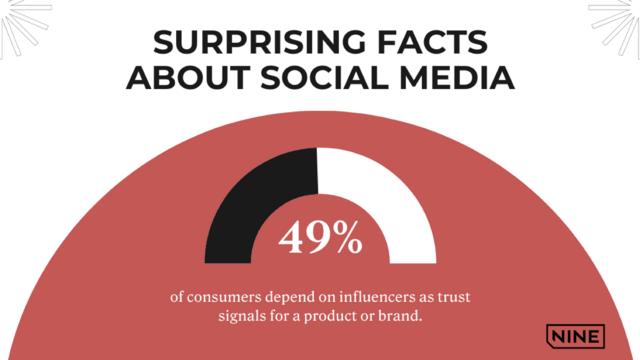
The Role of Social Media in Ecommerce
In today’s digital economy, the importance of social media in ecommerce is undeniable. It’s a requirement for companies to outpace the competition. ecommerce brands, big and small, need to dedicate capital, time, and resources to building their social media presence.
To maximize these platforms, your ecommerce company needs a social media director and/or works with an ecommerce digital marketing agency. With so many competitors pushing for social media success, you cannot take a lazy approach to any of the digital marketing platforms.
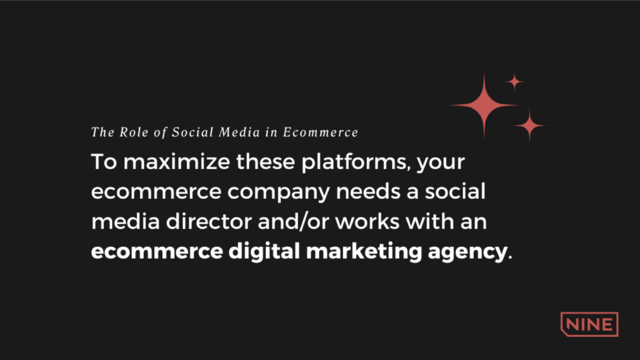
However, over-committing to the number of platforms you use can prevent your ecommerce business from gaining traction. Understanding the audience of each platform demographic can help you make the best decisions regarding where you should start.
Getting Started: How To Use Social Media For Ecommerce
Thinking about a social media strategy can be stressful and overwhelming. Hopefully, you’ve taken our advice and sought a social media specialist who, in some capacity, can join your team and support your digital marketing efforts. But even with an expert onboard, you might be unsure where to start driving commerce from these platforms.
Social media success requires the same psychological approach as any aspect of business does. Start small and focus on putting one foot in front of the other. Sign up, make a post, repeat.
Nobody becomes a social media success overnight. The good thing about this limited attention and fast-paced environment is that the audience will forget about initial posts after several swipes.
What’s important during the initial months of leveraging social media is keeping focused on your “why.” So instead of thinking about the millions of dollars you can make from social media, focus on these two critical focal points.
Discover New Customers
Every social platform allows you to reach new customers. Rather than focusing on the number of likes, think about how many new customers you get. That puts things into perspective. While you might consider 100 likes the appropriate amount of engagement from an audience, a single person who has yet to shop with your store can succeed.
Think about that. If you sell products worth $75.00 and that new follower who liked your post makes a purchase, doesn’t that seem worth the investment?
Stay Top of Mind With Existing Customers
Brands complaining about customer loyalty being a thing of the past need to self-reflect and take their marketing more seriously. People are not disloyal because you are no longer top of mind; they are simply excited about trying new product features they don’t know you have.
It’s your job to engage with existing customers. More than brand awareness, keep these in mind when considering how to keep your brand relevant to past customers.
Leverage social proof by showcasing reviews and customer experience.
Use visual representations to show each unique way consumers can use your product.
Attach your brand to the other interests of your past customers.
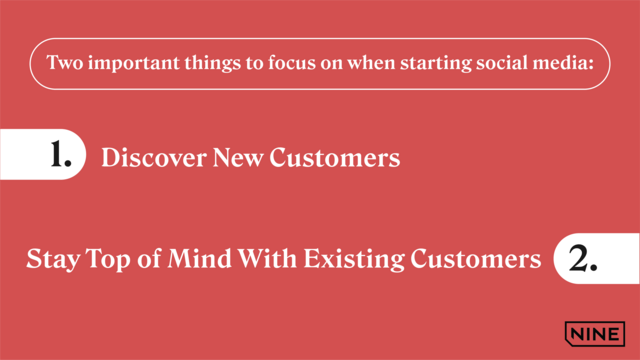
Creating a Universal Social Media Ecommerce Strategy
Before creating a platform-specific strategy, you must first create a broad one that applies to all platforms. While the tactics may change from Facebook to Instagram, the intent may be the same.
For example, let’s say you are an art subscription box company selling its product to homeschool families. You may have determined that customers cancel their subscription because they tire of cleaning up the mess. It would be best if you had a social media strategy for ecommerce that solves this problem.
Speak to your existing client base about reducing the required cleanup and tips on cleaning up quickly. Here’s a short list of actions to include within their ecommerce social media strategy.
List of cleanup supplies to keep on hand.
How to encourage children to clean up after themselves.
The best place to set up art projects.
Skills children need before starting messy art projects.
Reasons you should let kids make a mess.
Media type, visuals, timing, description length, hashtags, and many other variables change from platform to platform. However, they all address the same concern.
To create viral social media content, you first need to develop problem-solving content in a fun and unique way
Now, for developing an ecommerce social media marketing strategy, this probably isn’t what would come first to mind. Does this help you sell more products? Directly, no. But we are engaging with social media users in a way that fits the platform, adds value to their lives, and addresses buyer’s remorse.
Fact: Ecommerce social media posts rarely ask people to buy a product. You can only throw this type off the right hook when you have added significant value to your followers.
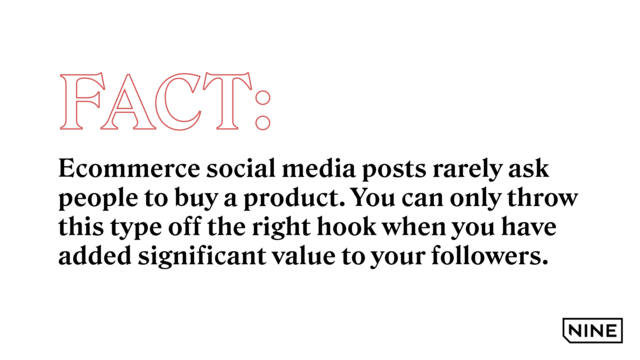
Determining Your Customers Preferred Social Media Platform
Finding out where your target audience is on social media may seem like a daunting task, but it isn’t that difficult. Here are two easy ways to determine where your customers spend the most time.
An established ecommerce brand can send out a survey asking past customers which platform they prefer. To get a better response rate, give a thank you discount code to those who take the survey.
A new ecommerce company can take its top 10 competitors and create a competitive analysis report listing each platform’s current reach and engagement.
Remember, the best social media platforms for ecommerce are different for every industry, age demographic, and product positioning. A coffee company such as Bulletproof succeeds with a different approach or platform than a company such as Folgers. To find the best ecommerce social media platform for your brand, gather as much consumer data as possible and then test what you’ve learned across each social media site.
Tips For Finding Social Media Content
You understand the importance of starting social accounts. You understand the importance of knowing where your customer spends the most time. But maybe you find it challenging to develop consistent and valuable social media content ideas for ecommerce.
We get this. Creating social media content can feel a bit like having writer’s block.
Look at other industries: with ideation, it’s better to look at different ecommerce product categories to find a fresh approach. Looking at your industry can feel like copying, and it’s always best to “appear” original on social media.
Create SEO Articles: Long-form SEO content marketing is a great way to create a long list of blog posts. All you need to do is customize the content specific to that platform.
Ask Your Customers: You’re already sending out a survey asking where they spend the most time, so why not ask them what type of content they prefer?
Check Your FAQ: You have a frequently asked questions section on your site already. Leverage the FAQ as a part of your social commerce strategy.
Leverage Social Media Influencers: We understand influencer's ability to sell products, but if spending money on influencers, doesn’t leverage their creativity make sense? There’s no better person to ask for social media insight than those who focus on becoming more relevant and recognizable to their audience.
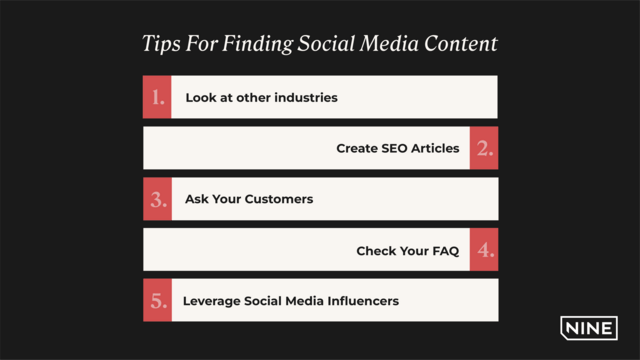
Paid Social Media Advertising
Unless you’re working with daddy warbucks cash, starting with organic social media marketing makes sense. However, paid ads are a vital part of a long-term ecommerce marketing strategy.
As mentioned, Facebook is essentially a pay-to-play business. So if this is where your audience spends the most time, you will need to think seriously about giving your posts a boost or running a Facebook ad.
For a while, Instagram was a free for all where posts magically turned into sales. Now, this platform is moving more to that of their brother Facebook. You can attract more Instagram users by investing in various social advertising options.
Examples of Successful Ecommerce Strategies
Trying to keep tabs on the latest social media ecommerce trends may seem like a daunting task but it doesn’t have to be. The best way to stay on top of social media marketing for ecommerce websites is to follow the category leaders. Let’s take a look at some of the ecommerce brands winning on social media.
TikTok Ecommerce Case Study: Fenty Beauty
Tutorials are an excellent way for ecommerce brands to show off their products. Especially if they enlist an influencer to do the job for them, this social proof and educational combo can be a one-two punch that establishes social sharing.
Fenty Beauty does such an excellent job of this that they created the collaboration house to support this initiative. But you don’t need Rhianna at the wheel to drive this strategy. Micro-influencers are available now more than ever and are continuing to rise in their ability to create engagement with their audience.
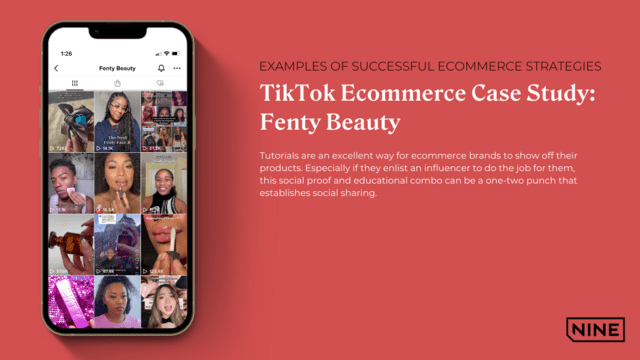
Instagram Ecommerce Case Study: Tiffany & Co.
Taking a defensive position, Instagram is rethinking its brand value proposition, as it no longer wants to be known as a photo-sharing app. While they’ve not released an official value prop, they’ve clarified how they want to be known as a platform for brief communications, fast navigation, and impulsive shopping. Doesn’t that sound a lot like TikTok?
While the future of Instagram’s growth projections may be unknown, we know they have the largest audience of all image and video-focused platforms. Where we might make the quick bucks on TikTok, you need to be on Instagram to reach the widest audience.
Tiffany & Co. is a fantastic example of how to use Instagram to expand your ecommerce customer base. They have done a great job carrying over the brand elements we all know, yet repurposing their messaging and tailoring it for a younger audience. They recognize that there isn’t an age restriction on luxury, so they are reaching their existing audience, moms and daughters alike.
Look at their Instagram stories and past live video streams for a workshop on including fun and playfulness in your marketing strategy.
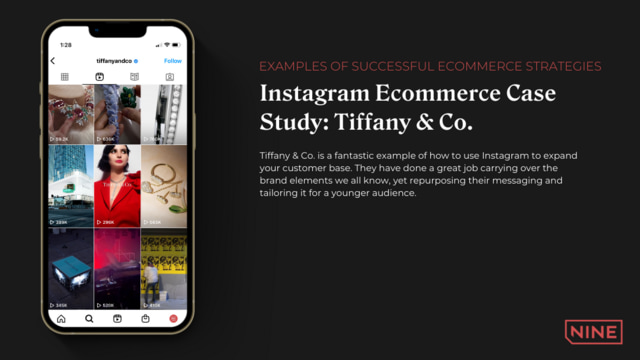
Facebook Ecommerce Case Study: Patagonia
They say you can’t teach an old dog new tricks, which may be why Facebook continues to have the most daily use of all platforms. Facebook exists for an established audience who like longer form content and to move at a bit of a slower pace. Those who enjoy navigating and browsing the marketplace and communicating with people of similar interests in Facebook groups.
This social network is perfect for a brand like Patagonia, which appreciates the “take your time” approach. Never in a hurry to increase revenues at the risk of environmental impact, Patagonia creates interesting posts that make people think differently about this brand than others.

Pinterest Ecommerce Case Study: Whole Foods
Any brand in the food and beverage space should still consider Pinterest and its ability to increase brand awareness. Pinterest may seem like a lesser relevant social channel, but what Pinterest ecommerce has that others don’t have is strong SEO. We can partially attribute this to the platform de-prioritizing images people want to protect, such as photos of their children.
Whole Foods is killing it on Pinterest with its rich pins. These rich pins include a call to action driving people to download coupons, recipes, apps, and more.
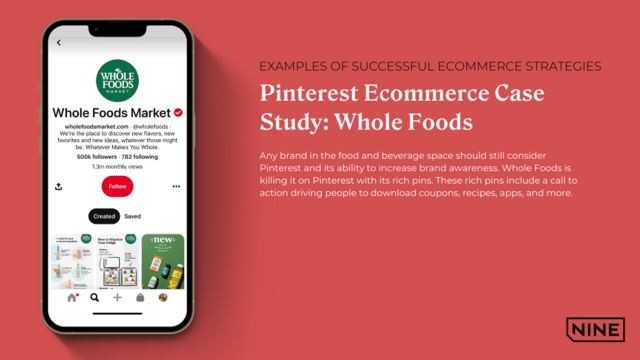
LinkedIn Ecommerce Case Study: Vista
LinkedIn might seem like a dead end for ecommerce brands, but this isn’t the case. LinkedIn pages can work for every ecommerce brand, but it’s imperative for B2B Ecommerce brands.
Vista takes a balanced approach to its LinkedIn marketing strategy by aligning its business with target audiences. Less about product promotion and more about engaging with their audience and associating with other brands in non-competitive spaces. Vista has over 100k followers on LinkedIn, consisting of business professionals who may consider them over the competition.
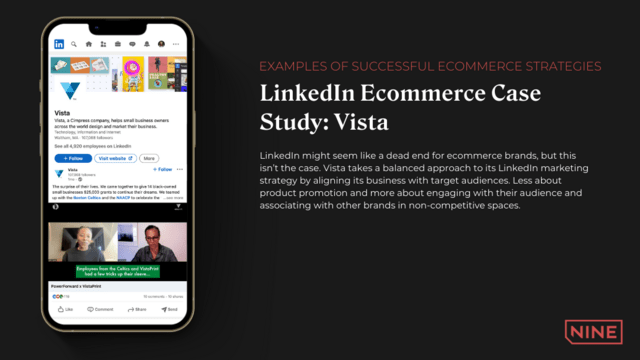
Twitter Ecommerce Strategies
It may seem that there are two approaches to Twitter. You can either be playful or political. Which will you choose? The obvious choice for a brand is to add an element of fun to twitter, but what if you had another option?
Like the origin of social media, Brands can use this platform for updates. Not just about product releases but anything relevant to their industry or purpose.
An excellent case study is Ruffles, which uses this platform to celebrate, update, and announce. It’s as if they are having a text conversation with a friend, and it’s fantastic!
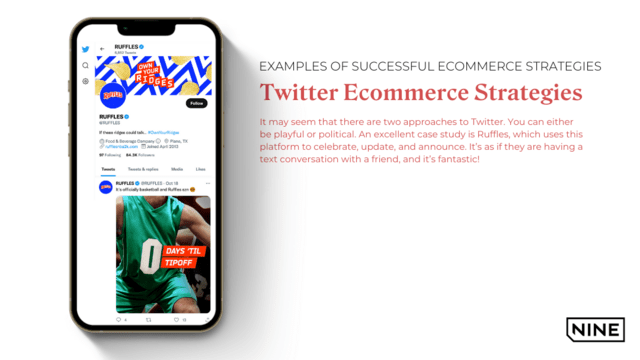
Ecommerce Social Media Marketing Agency
Want to see consistent growth on social media? The Nine is a digital ecommerce agency for ecommerce brands. Our social media specialists will highlight your company across all social media channels. From strategy to execution, our team builds long-term customers through creative posts, stories, reels, and more.
Schedule a time to discuss your ecommerce marketing with our team.

